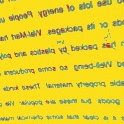CALL theory
CALL theory applied to language learning, as I understand
it, emphasizes integration of technologies into curricula, rather than using
the computer as an add-on, using the computer to extend learning beyond the
classroom, and keeping the focus on the learner in getting more opportunity to
use the language (Rilling et al., 2005). In the teaching world’s hurry to
integrate computers and their software into every aspect of language learning,
this is the best they can do to offer reasons why we should be in such a hurry. The computer offers us unlimited
opportunity for using the language, non-stop, every day, with people in any
corner of the globe. The world is rapidly moving over onto the computer anyway,
yes, and the skills students need to communicate on it are absolutely important
to their future success in that world.
CALL theory could be criticized for being somewhat vague, or
for not explaining why we should move
our entire language classroom over onto computers, or for not exploring what
sinister consequences might result, or for not tackling the question of whether
languages can be taught more easily or more efficiently this way. But these
questions are neglected temporarily in the rush, like a gold rush, to publish
articles in which we show how we are using certain technologies successfully,
both with students and with teachers, to advance the cause of language learning
in new environments, i.e. blogs, wikis, online fora, Skype, etc. It has become
commonplace to call upon CALL theory as a justification for learning and
managing these technologies, without noticing that CALL theory never tried to
justify them. CALL theory pointed out the obvious – that the world was moving
onto the computer anyway – and never tried to prove to us why this would be an improvement.
This is only the beginning. I need to learn more about this theory.
Labels: call theory, internet, learning theory


















































